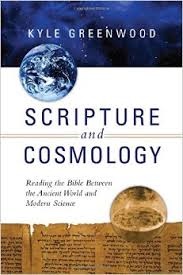 Kyle Greenwood, Scripture and Cosmology: Reading the Bible Between the Ancient World and Modern Science (Downers Grove, IL: IVP Academic, 2015). Paperback
Kyle Greenwood, Scripture and Cosmology: Reading the Bible Between the Ancient World and Modern Science (Downers Grove, IL: IVP Academic, 2015). Paperback
The Lord by wisdom founded the earth,
by understanding he established the heavens;
by his knowledge the deeps broke open,
and the clouds drop down the dew.
Proverbs 3:19–20 express the who, what, and how of creation. Who? The Creator is “The Lord,” that is, Yahweh, the God of Abraham, Isaac, and Jacob. What? He created “the earth,” “the heavens,” “the deeps,” and the “clouds.” And he did so expertly, with “wisdom,” “understanding,” and “knowledge.”
These verses also express an ancient Near Eastern cosmology. Israel shared with its Egyptian, Syrian, and Mesopotamian neighbors a three-storied universe consisting of heaven, earth, and seas. Though there were variations in the details of these culture’s cosmologies, the basic three-tiered structure was the same.
Modern people hold a very different cosmology than the ancients. We know, for example, that the earth revolves around the sun, not vice versa as the ancients believed. We know that the sun and the moon are not planets, as the ancients believed, and that there are more planets and planetary moons than the ancients could observe with the naked eye. Moreover, we know that our solar system is one among many in the Milky Way galaxy, which itself is one among many galaxies in an expanding universe.
The differences between ancient Near Eastern and modern cosmologies raise questions in the minds of Christians about “reading the Bible faithfully.” Kyle Greenwood outlines both questions and answers in Scripture and Cosmology: Reading the Bible Between the Ancient World and Modern Science. Greenwood is associate professor of Old Testament and Hebrew language at Colorado Christian University, whose Statement of Faith makes this declaration regarding the Bible: “We Believe the Bible to be the inspired, the only infallible, authoritative Word of God.” Though readers of all perspectives will find Greenwood’s presentation informative, Christian readers with a high view of Scripture will find it most helpful.
Scripture and Cosmology opens with a chapter about the importance of reading Scripture in context. In it, he states his book’s thesis: “a high view of Scripture employs a hermeneutic that accommodates the biblical writers’ immersion in their ancient, pre-Enlightenment cultural context. Therefore, as with other cultural matters, such as social customs and language, the biblical texts reflect that worldview in their written communications.”
Part One consists of three chapters that outline the similarities (and differences) between the cosmologies of the ancient Near East (specifically Egypt, Syria, Mesopotamia) and of Israel. Greenwood argues that both ANE and biblical texts assume a three-tiered universe consisting of the earth, the heavens, and the sea. He also contends that this three-tiered understanding of the cosmos serves as a better “guiding principle” for the Old Testament various creation accounts than does Genesis 1’s seven-day formula.
Part Two consists of two chapters that describe how the Christian church dealt with the challenges to this three-tiered biblical cosmology posed by first Aristotelian cosmology and then Copernican cosmology. Whereas ancient Near East cosmology depicted the earth as “small, flat and round”—a disk, in other words, Aristotelian cosmology pictured it as a sphere. And whereas Ptolemaic cosmology put Earth at the center of the universe, with the sun, moon, and heavenly bodies revolving around it; Copernican cosmology put the sun at the center, with the heavenly bodies, including Earth, revolving around it. (Contemporary cosmologies understand that the cosmos is acentric; neither the sun nor the earth is the center.) What Greenwood writes about the Aristotelian challenge might be equally applied to Copernican challenge: “The most notable trait we see among the Aristotelian-era interpreters is the willingness to adapt their interpretation of Scripture in light of new understandings of the physical universe.”
Part Three offers a theological rationale for this adaptation. Terming it “the doctrine of divine accommodation,” Greenwood explains the rationale this way: “God condescends his language to the language of humanity. This is not to say that God is condescending but that he speaks down to the cognitive ability of his human audience.” He offers this example: “Just as a father uses simple vocabulary and analogical language to communicate complex ideas to his children, so the heavenly Father accommodates his language to his children by speaking to his audience’s mother tongue and also employing analogical language.” Applied to biblical cosmology, accommodation entails that God speaks to Israel and its surrounding culture in terms of a three-tiered universe because that is what it believed. Were God revealing himself to our culture, he would accommodate himself to our cosmological speculations.
Over the centuries, accommodation has proved to be a fruitful line of thinking for Christians wrestling with the issues raised by a better scientific understanding of the physical universe. That doesn’t mean it is problem free. One wag has defined accommodation as “the theory which states that God goes along with the commonly accepted story even though he really doesn’t believe it.” Accommodation assumes that we can neatly distinguish between what culture assumes about a given topic and what Scripture teaches about it. Christians largely agree that accommodation is a good strategy when the Copernican Revolution is on the table, but Christians vehemently disagree when evolution is. Perhaps this indicates that while accommodation is a good interpretive strategy, it doesn’t necessarily decide all scientific cases.
Regardless, I commend Scripture and Cosmology for its in-depth look at the specific issue of biblical cosmology. It is well versed in the Bible and the texts of the ancient Near East, as well as cognizant of Scripture-science discussions throughout church history. And it is a thoughtful, irenic presentation of how to navigate the tensions between ancient cosmology and modern science.
—–
P.S. If you found my review helpful, please vote “Yes” on my Amazon.com review page.

